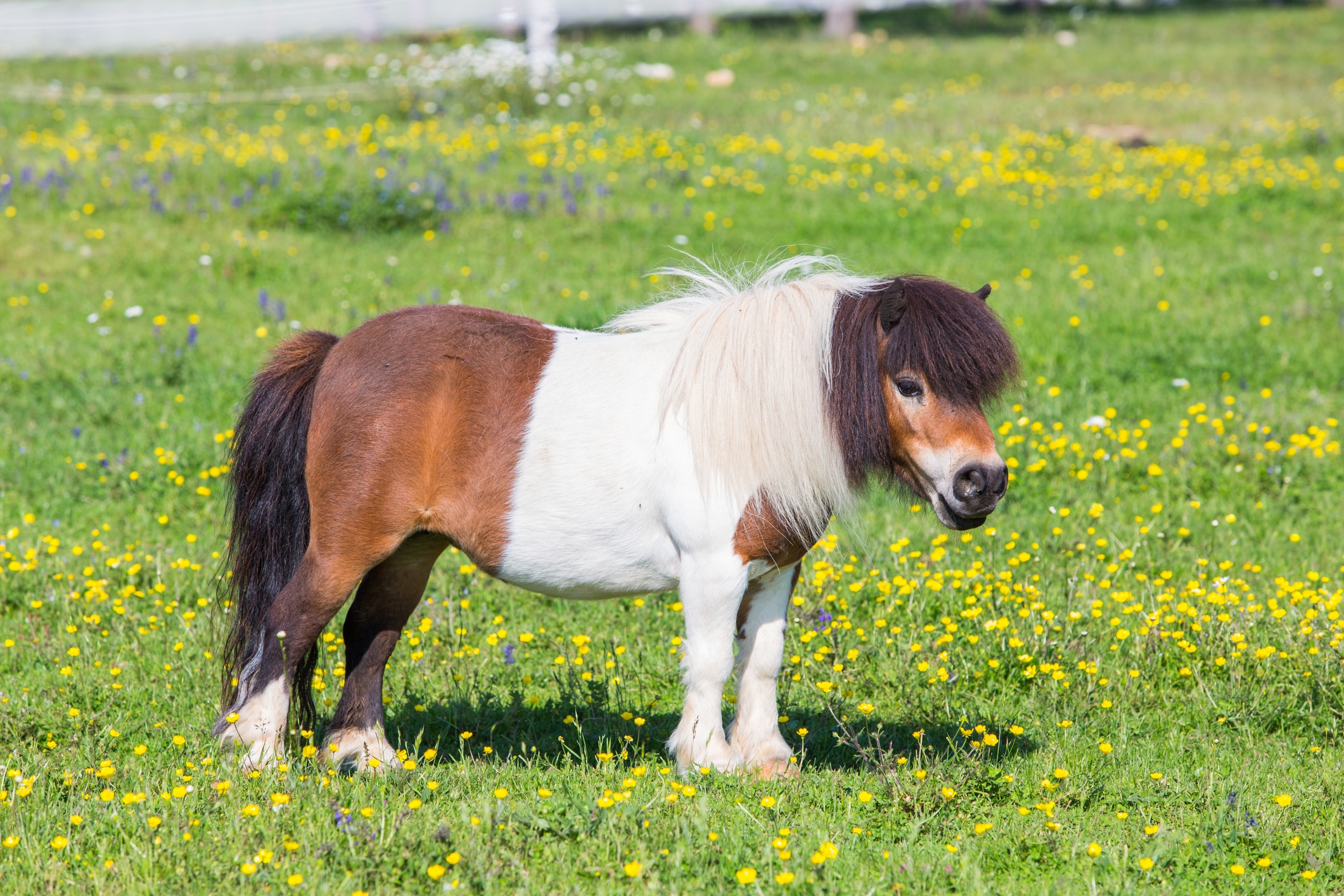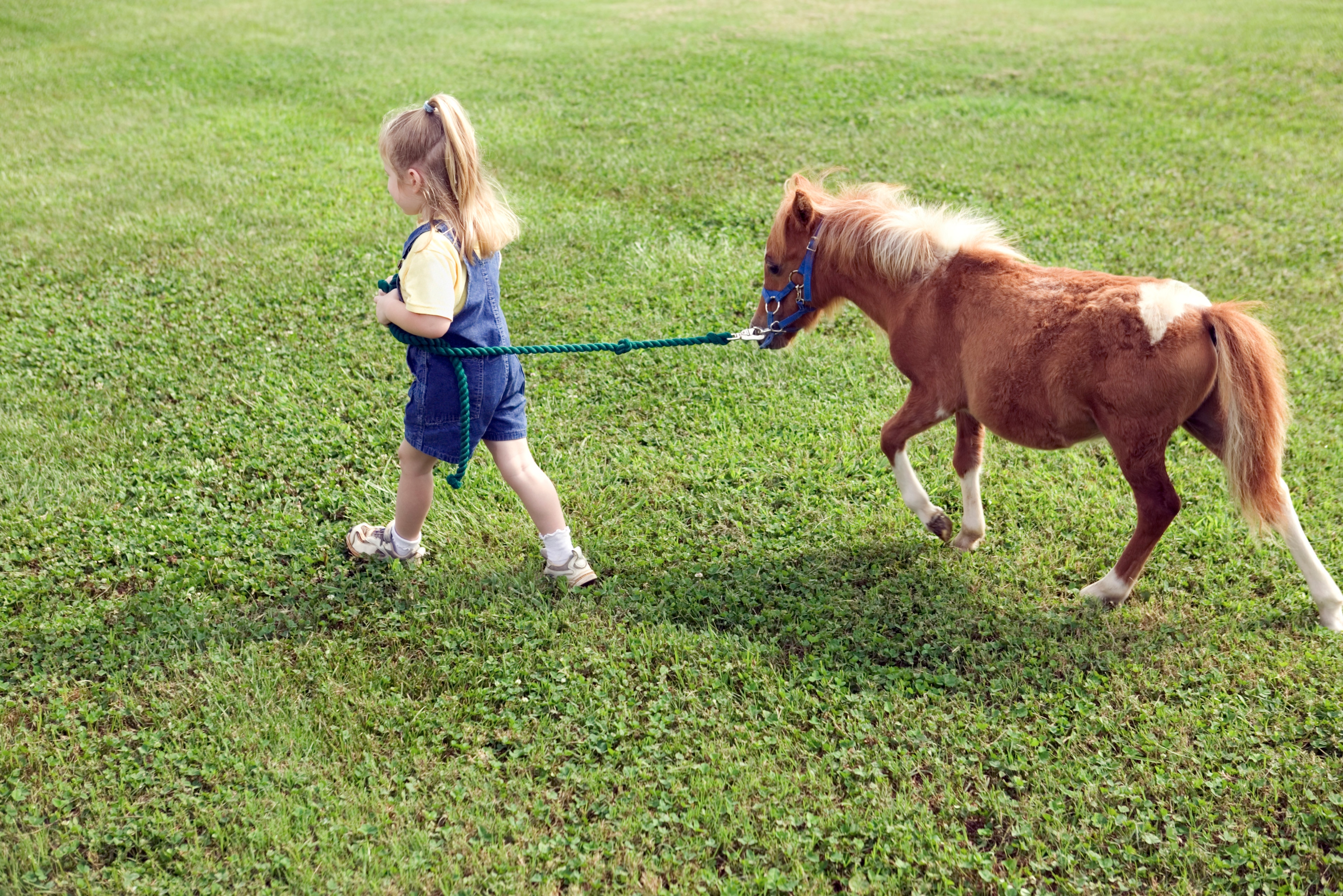Shetland Pony
Alan Morris/iStock / Getty Images Plus via Getty Images
The Shetland Pony is one of the smallest horse breeds, as well as one of the oldest.
They originated on the Shetland Islands in Scotland and date back thousands of years. They were believed to have arrived in Shetland at the end of the last ice age, and over time evolved to the ponies we recognize today.
As a strong and resilient breed, Shetland Ponies are popular for a variety of reasons, from their friendly disposition to their many talents and the ease of keeping them.
The American Shetland Pony Club (ASPC) is the registry for American Shetland Ponies, and the Shetland Pony Stud-Book Society registers the ponies in the U.K.
Shetland Pony Snapshot
-
Height: Under 11.2 hands (46 inches) to be registered
-
Weight: 400 to 450 pounds
-
Lifespan: 20 to 30 years
-
Colors: Any color, except spotted

Caring for a Shetland Pony
Shetland Ponies aren’t challenging to care for. They are small and have the same basic care requirements of their large-horse counterparts.
You’ll need to provide your pony with a clean stall, a high-quality diet that isn’t too high in calories, and a grooming routine that will keep their coat smooth and healthy.
These gentle horses enjoy a range of activities and are great for children who want an equine companion. When it comes to exercise and training, they don’t have any special requirements.
Due to their small size, Shetland Ponies can only be ridden by children, not adults.
Shetland Pony Health Issues
The average Shetland Pony lifespan is 20–30 years. They can be prone to certain genetic conditions, and health problems can develop if these horses aren’t properly cared for.
Health issues Shetland Ponies can develop include:
Equine Metabolic Syndrome
Shetland Ponies are known as easy keepers that can gain weight quickly, and that makes them prone to equine metabolic syndrome (EMS).
EMS increases a horse or pony’s risk of developing other health problems such as laminitis, so taking steps to prevent this disease is important.
Symptoms of EMS include:
-
Difficulty losing weight
-
High insulin levels
-
Fat deposits on parts of the body including tailhead, ribs, and neck
This condition can be treated with the right diet and exercise. Work with your veterinarian to develop a treatment plan unique for your Shetland Pony upon diagnosis.
Pituitary Pars Intermedia Dysfunction (PPID)
Pituitary pars intermedia dysfunction (PPID) is also known as equine Cushing’s disease. This endocrine disorder is typically diagnosed in horses 15 years and older, but it can occur in younger horses as well.
PPID impacts the pituitary gland and hypothalamus, causing an overproduction of adrenocorticotropic hormone (ACTH), as well as insulin dysregulation.
Symptoms can include:
-
Delayed shedding
-
Long, curly coat
-
Lethargy
-
Increased thirst and urination
-
Muscle loss
-
Potbelly
-
Exercise intolerance
-
Frequent infections
-
Delayed wound healing
-
Laminitis
Your veterinarian can provide guidance on how to manage this condition with medication as well as a proper diet and exercise routine.
Hyperlipemia
Hyperlipemia refers to high lipid levels in the blood. Lipids are a major component of cells, which typically are made of fats, oils, waxes, and hormones.
Increased lipids in the body can accumulate in organs like the liver, kidneys, heart, and muscles and damage these systems.
A chronically high amount of lipids can occur due to:
-
Stress
-
Obesity
-
Lactation
-
Poor diet
Potential symptoms of hyperlipemia in horses include:
-
Anorexia (decreased appetite)
-
Reduced water intake
-
Depression
-
Weakness
-
Weight loss
-
Trembling
-
Death
Supportive care may include:
-
IV fluids with dextrose and potassium
-
High-quality feed (via nasogastric tube if necessary)
-
Possible heparin administration
-
Addressing the underlying cause if known
Skeletal Atavism
Shetland Ponies can inherit skeletal atavism; about 12% can be carriers. This is a genetic condition that results in the horse’s leg bones not developing properly. It’s generally diagnosed when a foal is born.
Symptoms of skeletal atavism in horses include:
-
Short legs
-
Clubfoot
-
Low rectangular body
-
Impaired movement
-
Deformed knees and hocks, forcing limbs to grow at severely abnormal angles
-
Narrowing at knees
Unfortunately, because this condition worsens as the foal grows, humane euthanasia is typically elected within the first year of life.
Laminitis
Shetland Ponies are at higher risk of laminitis, which is inflammation and damage of the laminae, the tissue between the coffin bone and hoof.
The condition is also known as founder and has several causes, including:
-
Improper diet or grain overload
-
Obesity
-
Trauma
-
Systemic illness
-
PPID
-
Equine metabolic syndrome (insulin dysregulation)
Symptoms of founder in horses include:
-
Difficulty walking or getting up (down horse)
-
Increased heart rate
-
Increased respiratory rate
-
Increased digital pulse
-
Shifting weight while standing
-
Taking a sawhorse stance (front legs stretched forward with hind legs under the body)
Preventing this condition, as well as treating it promptly with the guidance of a veterinarian, is important.
Diagnosis is typically made with a physical exam and X-rays by your veterinarian.
Founder may be treated with:
-
Anti-inflammatories (phenylbutazone)
-
Therapeutic shoeing/trims and boots (such as Soft-Ride Boots©)
-
Medications to aid blood circulation to the foot
-
Other therapies, depending on the underlying cause
In severe cases, laminitis can worsen to the point that humane euthanasia is recommended.
What To Feed a Shetland Pony
Because the Shetland Pony can gain weight easily, feeding them a proper diet is crucial. You can provide your pony with mature grass hay, straw, and ration balancers along with a salt block and clean water.
To figure out roughly how much your pony needs to eat daily, calculate 2% of their weight. For example, if your Shetland Pony’s weight is 425 pounds, they would need about 8.5 pounds of food daily.
It’s important to create a balanced diet with your veterinarian based on your horse’s age, activity level, and metabolic status.
Avoid giving your Shetland Pony commercial grain-based diets that are high in calories, and reduce the amount of sugar and starch in their diet. Hay-based diets and forage that’s high in fiber are good choices. Adding some straw can also help reduce calorie intake.
To figure out roughly how much your pony needs to eat daily, calculate 2% of their weight.
For Shetland Ponies, slow feeders and grazing muzzles may be useful to ensure they don’t consume too many calories both in their stall and out on pasture.
Soaking the forage can also help minimize the amount of sugar your horse consumes.
Keep an eye on your Shetland Pony’s weight and body condition. If you have any concerns, discuss nutritional supplements with your veterinarian to ensure your pony is getting what they need.
Shetland Pony Disciplines
Adults should not ride Shetland Ponies, but young children can. Shetland Ponies can carry kids who weigh up to 90 pounds.
In addition to making great pets, Shetland Ponies can work as therapy horses. They are often used in horse shows, competitions, and farm work, such as racing and harness driving. You might also see these ponies at fairs and petting zoos.

Shetland Pony Personality and Temperament
The cute Shetland Pony makes a great pet for horse owners of all ages and all experience levels, including children. Of course, every horse is an individual with a unique personality, but these ponies are generally known for being playful, intelligent, friendly, and gentle.
However, Shetlands can also be stubborn at times, which can make them a bit difficult to handle. Properly training your horse helps ensure their positive traits shine.
Although these ponies are smaller than other horses, it’s important to train good behavior and safety from a young age so Shetlands can be safe to work around.
Shetland Pony Training
You can train a Shetland Pony in the same way that you’d train a full-size horse. And because these horses are smart, you can make great progress if you take the right approach.
The cute Shetland Pony makes a great pet for horse owners of all ages and all experience levels, including children.
Positive training techniques are best. Be gentle and respectful, so your horse will learn to trust you and feel totally at ease around you. Keep in mind that Shetland Ponies can be stubborn and patience is required. Never use punishment to train your Shetland.
Shetland Pony Grooming Guide
Grooming requirements for the Shetland Pony are the same as for many other horses. These ponies have a thick, double coat when it’s cold and shed their coat when the weather warms up.
Coat Care
To keep your Shetland Pony’s coat healthy, follow a consistent grooming routine that removes dirt, debris, dander, and loose hair. Try to do this several times a week.
Your horse grooming kit should include a curry comb, shedding blade, and dandy brush to make cleaning the coat easy. Soft-bristled brushes can be used on delicate areas like the legs and face.
You can also ensure this pony’s thick mane and tail is smooth and tangle-free by using a mane and tail brush.
Hoof Care
Check your Shetland Pony’s hooves every day to look for signs of infection or injury, and clean the hooves carefully with a high-quality hoof pick. A brush designed for use on the hooves can also be useful in removing dirt and debris.
Have a farrier check your horse’s hooves regularly for proper trimming and shoeing.
Shetland Pony FAQs
How much does a Shetland Pony cost?
Several factors can affect the price of a Shetland Pony. For example, you might be able to adopt one of these ponies for a price as low as $200. If purchasing from a breeder, the cost may depend on the pony’s lineage, training, and age. Prices could range from under $1,000 to $8,000 or more.
How long do Shetland Ponies live?
The Shetland Pony’s average lifespan is 20 to 30 years, but they can live longer with proper care. A British Shetland Pony named Bamboo made headlines when he turned 50 in 2021.
How much does a Shetland Pony cost to keep?
The Shetland Pony might be slightly more affordable to keep than a larger horse, but they have the same care requirements. Costs vary, based on factors like location and feed prices. You can generally expect to spend several thousand dollars annually on everything from veterinary care and a farrier to board and food.
How much does a Shetland Pony weigh?
The average Shetland Pony weight is 400 to 450 pounds.
What’s the difference between a Miniature Horse and a Shetland Pony?
The Miniature Horse is a separate breed—they are tiny versions of full-sized horses, not exceeding 34 inches tall. Shetland Ponies are heavier and stronger than Miniature Horses.
